By Marie-Noelle NWOKOLO
Ghana’s football legacy is rich, but without a functional development ecosystem, we’re leaving jobs, revenue, and national potential on the bench.
Ghana’s football legacy is storied, its talent admired worldwide. But without a functional development ecosystem, we continue to leave jobs, revenue, and national potential on the bench.
In July 2010, as the vuvuzelas roared across Johannesburg, the hopes of a continent rested on the shoulders of Asamoah Gyan. With one penalty kick, Ghana could have become the first African nation to reach a World Cup semifinal. He missed. And while Uruguay celebrated, Africa mourned. But that moment – heartbreaking as it was – signalled something extraordinary: Ghana had arrived. Not just as a participant, but as a contender.
Fifteen years later, the deeper question lingers: Why haven’t we done more with that global capital?
In a world where people earn unconventionally from TikTok to tech startups, why isn’t Ghana strategically monetising its most beloved, most watched, and arguably most exportable asset: football?
The answer lies not merely in sports, but in systems – or rather, their absence.
Ghana’s football story is world-class. We’ve won the Africa Cup of Nations four times. Our U-17s dominated the world in the ’90s. We’ve produced stars like Abedi Pele, Michael Essien, Asamoah Gyan, and more recently, Thomas Partey and Mohammed Kudus. Yet their success stories remain largely individual. We have yet to build a system that translates individual excellence into collective, structural progress.
The Real Problem: No Functional Football Development System
Football in Ghana is celebrated, not capitalised. Loved, but not leveraged. It remains entertainment, not enterprise. What we lack is a coordinated development ecosystem that converts footballing talent into structured economic, educational, and national outcomes.
This disconnect reveals five interlinked failures:
Policy Failure
There is no politically committed, operational strategy linking football to youth employment, education, or national branding. Countries like Senegal have explored this linkage.
The Diambars Institute, founded by football professionals including Patrick Vieira, combines academic training with elite football instruction. How it emerged, who drove it, and how it continues to function are questions we should be interrogating, not just to replicate, but to learn from.
Institutional Fragmentation
Key ministries and agencies, including Youth and Sports, Education, and Finance, as well as the Ghana Football Association (GFA), operate in silos. No shared targets, no coordinated budgets.
The result? No pipeline. No plan. According to the Auditor-General’s 2022 report, the Ministry of Youth and Sports (MoYS) failed to fully disburse the budgeted support to community football initiatives. Meanwhile, the GFA has faced recurring transparency issues in its financial reporting, which has undermined trust with both the public and private sector investors. Germany faced a similar breakdown after its Euro 2000 debacle.
In response, it mandated that all top-tier clubs create licensed academies tied to education. Backed by €680 million, it built a pipeline that produced Thomas Müller and Manuel Neuer. By 2014, it wasn’t just winning trophies, it was reaping the rewards of an adaptive, learning-driven system.
Incentive Failure
There is little reason for local investors or retired players to build domestic football systems when bureaucracy is opaque, and returns are uncertain. The recent MTN FA Cup final—marred by controversy—only reinforces why some hesitate.
Yet, models like Côte d’Ivoire’s ASEC Mimosas & Académie MimoSifcom show that football can be both a business and a development tool. Its academy has produced global stars (think Yaya Touré, Gervinho and Emmanuel Eboué), reinvested earnings, and sustained a world-class pipeline.
We must ask: What allowed that ecosystem to thrive? And who enabled it? Take, also, for example, 13-year-old Camden Schaper, a South African prodigy nurtured at SuperSport United’s academy in Pretoria.
The club’s system – scouting talent from SAFA tournaments, offering free education, life-skills training, and elite medical and coaching support – echoes the kind of dual-purpose model Ghana needs. Under this structure, Schaper captained the U‑11s on an unbeaten Spanish tour, drew interest from Sporting Lisbon by age eight, and logged five-star performances in Blackburn’s youth ranks before Chelsea reportedly bid £700,000 for him.
Yet despite this nurturing environment, he and his family relocated to the UK in 2023 to pursue his dreams, raising compelling questions such as: what stops a system from retaining its talent? If Ghana is to build not just pipelines but ecosystems, we need to understand that question deeply. Who decides when talent leaves? What local capacity was exhausted? And how can pilot models surface those insights in real time?
Capability and Learning Deficit
Public agencies often lack the necessary tools and planning systems to implement effective reform. Worse, we’ve failed to reflect on and learn from our history — the 1991 and 1995 youth triumphs, as well as the 2010 World Cup run — all have vanished into nostalgia without substantive reform.
Why It Matters: Football as Industrial Policy
In the UK, sport contributes over £99 billion to GDP and supports more than 1 million jobs. In 2021 alone, sports activities added £53.6 billion in direct Gross Value Added. However, the UK’s success isn’t just about output; it’s about the process. Coalition-building, smart regulation, and patient investment created the conditions for monetization. We need to understand how they got there, not just what they built.
Equally, we must study failure. South Africa’s 2010 World Cup offers a cautionary tale. Despite adding 0.5% to GDP and creating temporary jobs, the benefits were highly uneven. Infrastructure served already-wealthy areas. FIFA’s rigid sponsorship system allegedly sidelined local entrepreneurs. And tourism returns were dismal. Scholars like Mirele De Aragao argue that the real cost was what was not funded: education, healthcare, and employment systems.
The question then becomes, what if we saw football not as frivolous, but as strategic?
Where Might We Begin? Learning, Not Prescribing
A few entry points worth exploring:
- Could a cross-ministry task force define shared KPIs for football and youth employment?
- Could dual-purpose academies become national learning labs?
- Could diaspora players co-finance infrastructure through matched public funds?
- Could football-linked tourism (e.g., Abedi Pele museum) become a new export product?
- Could a national football data system create value for scouts, clubs, and broadcasters?
These are not silver bullets. They’re prompts – experiments to be piloted, adapted, or abandoned based on what we learn. None promise transformation alone. But together, they could offer iterative learning loops that will quite literally change the game for Ghana and Ghanaians. That’s where real reform starts.
We’ve Played Enough Exhibition Matches
Ghana has the talent. The passion. Even the capital. What it lacks is a system.
Football is more than a sport in Ghana. It is identity. Unity. Soft power. But soft power without structure is sentiment. If we want jobs, revenue, and national pride, we must build institutions that treat football not as nostalgia, but as a strategic asset.
Reform doesn’t begin with blueprints; it starts with confronting uncomfortable truths, asking the right questions, and learning our way forward. Football can be a test case for something bigger – a model for how we rebuild broken systems by building better ones, bit by bit, match by match.
The missed penalty in 2010 was painful. However, the greater tragedy would be to continue missing the point. It’s time to be strategic, intentional and committed to the sport we claim to love so dearly.
Marie-Noelle Nwokolo is a researcher and policy advisor focused on growth and economic development. She writes in her capacity as a concerned but optimistic Ghanaian.
This piece was originally published in the Daily Maverick.










